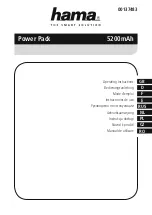
User Manual
22
Note:
The aluminium foil discs
(
21
)
have a matt surface and a shiny
surface. Contact of a particular foil surface with the sample
whilst pressing, will determine the amount of spectroscopic
interference fringes produced by the thin film. If a reduction in
spectroscopic interference fringes is sought, the matt surfaces of
the two foils should be in contact with the sample. Conversely, if
fringes are required, (e.g. to measure the film thickness) then the
shiny surfaces should be in contact with the sample.
Making the Aluminum Foil Sample Cup
The aluminium foil sample cup consists of a lower sample cup (
22
) part
and a top cover (
23
) part made from the 40mm diameter aluminium foil
discs (
21
) supplied. These cup parts are made using the special cup
making tool (
24
). A foam pad (
25
) with two different size recesses is
used with the special cup making tool (
24
) to create the sample cup
parts (
22
) and (
23
) from a foil/foam pad/foil “sandwich” of components
that are compressed within the circular jaws of the cup making tool
(
24
). (See
Fig 9.
)
Fig 9. Parts of the Aluminium Foil Sample Cup
and Cup Making Tool
To make a sample cup (
22
), using the forceps supplied first place a
40mm diameter foil disc (
21
) inside the large (40mm diameter)
recessed area of the foam pad (
25
). The foil discs (
21
) have two
different surface finishes – one shiny and one matt. If a reduction of
23
24
22
25
Summary of Contents for Atlas GS15800
Page 1: ...Atlas High Temperature Film Maker Accessory User Manual 2I 15800 Issue 15...
Page 2: ......
Page 3: ...Atlas High Temperature Film Maker Accessory User Manual 2I 15800 Issue 15...
Page 45: ...Atlas High Temperature Film Maker Accessory 43...
Page 46: ...User Manual 44 Notes for Use of Atlas High Temperature Film Maker Accessory...
















































